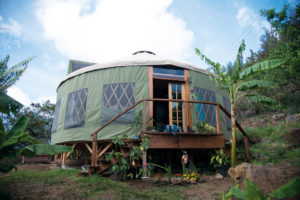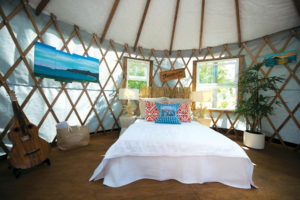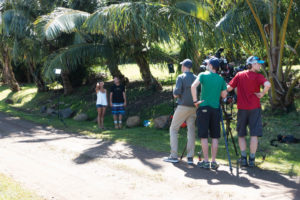Ohana Yurts encourages sustainable living, one yurt at a time.

Photos: Ohana Yurts
To Jenny and Nathan Toler, a yurt is more than a temporary shelter or even a permanent home; it’s a way to reconnect with the earth. “It’s living in the environment as opposed to being protected from it,” explains Nathan, who owns Haleiwa, Hawaii-based Ohana Yurts with wife Jenny.
The Tolers’ commitment to living sustainably is what brought them into the yurt business—and what keeps them there. They founded the company in 2010 after building yurts for the Positive Energetics Foundation, a nonprofit alternative wellness center they also founded. A goal of the nonprofit was to build an eco-village on Oahu, but no companies offered local yurt-building materials, and sourcing them from the mainland was too expensive and too long a process.
Not the types to give up, they took on the challenge of making the structures themselves. “The first one we made fell apart,” Jenny recalls. “So, we kept refining and designing,” a process they continue to this day. “The next thing I knew, every yurt I built, someone purchased,” Nathan says. “I couldn’t keep them around, and that’s how Ohana Yurts started.”
Central support

and roof rafters that are built around a central compression ring, which keeps the yurt stable.
A yurt is a round structure, wrapped in fabric, that consists of wood lattice walls and roof rafters built around a central compression ring that provides rigidity. The roof and wall are grommeted together, the walls are pulled tight and then fastened at the lower deck. A 4,000 psi coated aircraft cable sits on top of the lattice and fastens to each roof rafter. When winds push against one side of the yurt, the compression ring pushes back against the pressure, keeping it stable.
In true partnership form, Nathan makes the wood components from local trees, while Jenny sews all of the fabric using their Reliable Corp. long-arm sewing machine. Everything is hand-cut, milled and customized for the client. “Not one of our yurts is truly the same,” Nathan says. “We keep wanting to find ways to streamline the process, but manufacturing takes away from the coolness aspect of having one hand-built.”
Once all of the components are ready, setting up a structure is a fairly short process:
A 12-foot yurt can go up in about three hours; a double-decker can take three days.
Climate challenges
Though these structures can adapt to any climate, the Tolers specialize in tropical yurts. “They’re an awesome way to go in Hawaii, as opposed to traditional housing, because of the massive shipping cost for lumber,” Nathan explains. “Plus, because land is expensive, when someone is leasing it, we can just break the yurt down and move it to a new site.”
The tropical climate requires the fabric to withstand high humidity, acid rain, vog (smog or haze containing volcanic dust and gases) and intense UV exposure while remaining breathable. For these reasons, Ohana Yurts uses Sunbrella® and WeatherMAX® marine-grade fabrics. Because of its location, access to this material remains one of the biggest challenges, as shipping is often more expensive than the fabric, Jenny explains. The Tolers order most of their material from Keyston Bros., who once had a location in Hawaii. They now rely on a branch in Seattle.
A 30-foot premier yurt requires 400 yards of fabric, while about 60 yards are used for a 12-foot yurt. “The yurts should stay cool, so we don’t use PVC-coated fabrics because they hold heat in,” Nathan says, adding that they’ve also found PTFE thread to be the best for maintaining the structures’ long life span—the company offers a 10-year warranty with each one.
Distinguished design
Ohana Yurts customers—the majority of whom are based in Hawaii, American Samoa and Fiji—request a range of uses for the yurts: complete homes, second bedrooms, yoga lofts, art and music studios, game rooms or farm-related buildings, for example.
Prospective clients first tour a variety of yurts to get a feel for what living in one is like. Once size is decided—anything from a 12-foot yurt covering 114 square feet to a 16-foot yurt covering 202 square feet to a 30-foot deluxe yurt covering 1,400 square feet—they talk design. “That’s where it really gets fun,” Nathan says. For turn-key yurts, which are ready to be lived in immediately, the customer works with both Nathan and Jenny—who also call upon the skills of Nikki Parlow, a local interior designer—to come up with the layout, color scheme and style. “From there, about 90 percent of the interior is custom-built with furniture from our deadwood furniture line and milled local wood for counters, sinks, stairs and shelving,” he continues.
The Tolers see yurts becoming more popular as people look for ways to live a simpler lifestyle, and functionality—along with style—is a distinguishing factor for their company. Their windows, for example, provide accessibility on the inside, in contrast to the exterior window flaps most other yurts offer.
It’s a lifestyle
The environmental benefits of yurt living remain the biggest inspiration for the Tolers, who live in a 30-foot premier yurt with their family and also do their own organic farming. “Living with the ‘aina’ (land) ultimately means freedom,” Nathan says. “We have been doing so, in part, for about six years. It’s taking control of your health and accepting personal responsibility for taking care of the aina—something we have lost touch with in the U.S.”
Several advantages are detailed on their website, including: “The yurt remains an easy and affordable structure to build because it requires only a fraction of the material a conventional home would call for … The simplicity of the yurt’s framework not only reduces the amount of raw materials used to build a home but also drastically reduces the amount of natural resources and labor required to erect the structure.”
In addition, they explain that the structures’ circular shape promotes proper circulation of light, air, heat and sound, creating a more energy-efficient space. And unlike traditional, square-shaped homes that encourage more space for families to fill with furniture, electronics, etc., yurts optimize floor space usage.
“Seeing how happy customers are after they move into their yurt is the best,” Jenny says, noting that clients tell her it benefits their entire lifestyle: “not so much the yurt itself but the compound of choices—choosing to go out of the box and try something new.”
A wider reach
The Tolers’ enthusiasm eventually caught the attention of HGTV. “Word got out that this family was living in yurts on farmland, completely off the grid,” Nathan explains. “So, they found us.” After being featured on an episode of “Tiny House, Big Living,” HGTV offered them their own show—“Love Yurts,” which premiered on the DIY Network in December 2016.
“It’s challenging but an awesome opportunity to spread the word about yurts and alternative living,” Nathan says about the stress of filming. “Sales at yurt companies are up because of the show, so it’s nice to know we had that kind of impact.” Jenny notes another benefit of the increased visibility: Fabric companies who have seen the show have been sending product samples. “Innovation is our goal as we experiment with new materials, so it’s a great way for us to keep trying new things,” she says.
As they continue taping 12 new episodes, the Tolers are wrapping up older projects and looking ahead to new challenges. They recently finished building a new workshop, complete with a clear-span roof. “We hadn’t done one before, but that’s how we seem to operate—trial and error,” Nathan says. They’re also working to create inventory for their indoor/outdoor furniture line and offer a new FULCRUM package to clients: a yurt featuring built-in, solar-heated water, a water catchment system and built-in exterior garden boxes. “It’s everything you need to live sustainably,” he says.
 TEXTILES.ORG
TEXTILES.ORG



